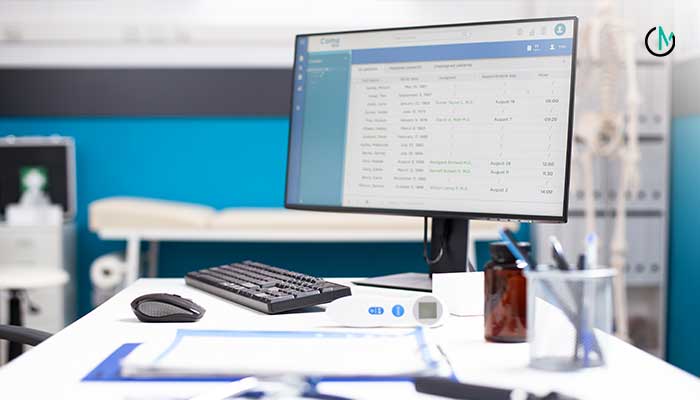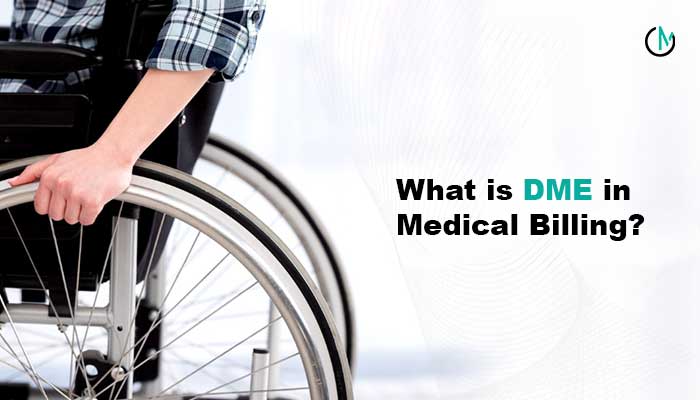What is DME in Medical Billing? - Important Things To Know
- July 16, 2025
- 0 Comments
- DME Billing
Have you ever had a doctor prescribe something like a wheelchair, crutches, or a breathing machine? These are not medications or surgeries, but they are essential medical supplies that help patients live more comfortably at home. In healthcare, these supplies are called Durable Medical Equipment (DME).
Durable Medical Equipment includes reusable medical devices such as hospital beds, walkers, CPAP machines, and oxygen equipment. These items are built to last and are used to assist people in managing health conditions outside of hospitals or clinics.
In this blog, you will learn everything about DME in medical billing. You will understand what qualifies as DME, how the billing process works, who pays for these items, and how to avoid common billing problems. This guide will help healthcare providers and patients better understand how to handle DME billing in a smooth and hassle-free way.
What is DME (Durable Medical Equipment)?
DME stands for Durable Medical Equipment. These are reusable medical items that doctors prescribe to help people manage their health problems while staying at home. DME is built to last and can be used over and over again, making life easier for patients who need extra care outside of hospitals.
Examples of DME include things like wheelchairs, walkers, crutches, hospital beds, and oxygen machines. These items are not for one-time use—they are designed to support patients for weeks, months, or even years, depending on their health needs.
According to Medicare.gov, DME is usually covered by insurance when a doctor says it is medically necessary and the equipment is on the approved list. This makes it more affordable for patients to get the equipment they need to recover or manage their condition safely at home.
Common Examples of DME:
- Wheelchairs
- Walkers and crutches
- Hospital beds for home use
- Oxygen machines
- CPAP machines for sleep apnea
- Blood sugar monitors for diabetes
Basically, DME helps people live more comfortably at home without needing to stay in a hospital.
Why DME is Important?

Durable Medical Equipment (DME) is an important part of healthcare because it helps patients stay healthy and comfortable at home. Whether someone is recovering from surgery or living with a long-term illness, DME provides the extra support they need in their daily life.
Helps Patients Recover at Home
DME allows people to heal at home instead of staying longer in the hospital. Items like crutches, wheelchairs, or hospital beds help patients recover safely and comfortably after surgeries or injuries.
Makes Life Easier for Long-Term Illnesses
For people living with long-term health problems, DME can make daily activities easier. For example, a patient with breathing problems might use an oxygen machine every day, or someone with sleep apnea may need a CPAP machine every night to sleep properly.
Reduces the Need for Hospital Visits
When patients have the right medical equipment at home, they can avoid unnecessary trips to the hospital. This not only saves time and money but also helps patients feel more relaxed in their own space.
Covered by Medicare
Medicare recognizes the importance of DME in improving patient care. That’s why many DME items are covered under Medicare Part B—but only if they are medically necessary and prescribed by a doctor. You can see the full coverage details on the Medicare website.
How DME Billing Works

Billing for Durable Medical Equipment (DME) is a little different compared to regular medical services. DME billing involves several steps to make sure the patient receives the correct equipment and that the healthcare provider or supplier is paid properly. Below is a step-by-step breakdown of how the process works.
Step 1: Doctor’s Prescription is Required
The first step in DME billing starts with a doctor’s prescription. A licensed healthcare provider must check the patient’s condition and decide if DME is medically necessary. This prescription proves to insurance companies that the patient truly needs the equipment. Without a prescription, insurance will not pay for the DME.
Step 2: Choosing a DME Supplier
After getting the prescription, the next step is to choose a DME supplier. This is a company that provides the equipment to the patient, either by selling or renting it. It’s important to choose a supplier that works with the patient’s insurance.
For patients using Medicare, it’s best to pick a supplier who is part of the DMEPOS Competitive Bidding Program, which helps lower costs for certain items. The official CMS DME Center provides information on approved DME suppliers across the country.
Step 3: Prior Authorization from Insurance
In many cases, prior authorization is required before the equipment can be delivered. This means the supplier must first get approval from the patient’s insurance company.
Insurance reviews the doctor’s prescription and medical records to confirm if the DME is really needed. Without this approval, insurance may refuse to pay for the equipment later. You can read more about the prior authorization process on the CMS website.
Step 4: Claim Submission to Insurance
Once the prior authorization is approved, the supplier provides the equipment to the patient. After this, the supplier submits a claim to the insurance company.
This claim includes:
- The billing codes (called HCPCS codes) for the equipment
- A copy of the doctor’s prescription
- Any supporting documents explaining why the DME is necessary
The claim explains exactly what was provided and why the insurance company should pay for it.
Step 5: Payment Approval or Claim Denial
After reviewing the claim, the insurance company will either:
- Approve the payment and pay the supplier
- Deny the claim and refuse payment, often giving a reason such as missing information or the equipment not being covered
If a claim is denied, the patient or supplier can file an appeal to challenge the decision.
Who Pays for DME?
One of the most common questions patients and healthcare providers ask is, “Who pays for Durable Medical Equipment (DME)?” The answer depends on the type of insurance the patient has. Most people don’t have to pay the full cost out of pocket, but it’s important to understand how coverage works.
1. Medicare Coverage
For patients with Medicare, many DME items are covered under Medicare Part B. Medicare usually pays for 80% of the cost of approved DME after the patient meets their yearly deductible. The patient is responsible for paying the remaining 20% out-of-pocket.
However, coverage is only provided when:
- A doctor prescribes the equipment
- The DME is medically necessary
- The equipment comes from a Medicare-approved supplier
You can learn more about exactly what is covered on the official Medicare website.
2. Medicaid Coverage
Medicaid also pays for DME, but the rules are different in each state. Some states may cover more types of equipment, while others may have stricter guidelines. Medicaid usually requires the same things as Medicare—a doctor’s prescription and medical necessity.
Patients and providers can visit the Medicaid.gov DME benefits page to see what DME services are available in their state.
3. Private Insurance Coverage
Private health insurance companies like Blue Cross Blue Shield, UnitedHealthcare, Aetna, and others also offer DME coverage. But every insurance company has its own set of rules:
- Some plans may fully cover DME
- Others may require co-payments or prior authorizations
- Certain items may not be covered at all
Before ordering or renting equipment, it’s always a good idea to call the insurance company and check:
- If the DME is covered
- How much the patient will have to pay
- Which suppliers are in-network
4. Out-of-Pocket Payment
If insurance denies coverage or a patient doesn’t have insurance, the patient may need to pay for the DME out-of-pocket. In many cases, patients can rent the equipment instead of buying it, especially if they only need it for a short time.
Some DME suppliers offer rental options for items like wheelchairs, crutches, and hospital beds to make it more affordable.
What Are DME Billing Codes?

When it comes to billing for Durable Medical Equipment (DME), using the right codes is very important. These special codes are known as HCPCS codes, which stands for Healthcare Common Procedure Coding System.
What Are HCPCS Codes?
HCPCS codes are used by healthcare providers, billing companies, and DME suppliers to describe medical equipment when submitting insurance claims. Each type of DME has a unique code. This helps insurance companies understand what equipment was given to the patient and why payment is being requested.
Examples of DME HCPCS Codes
Here are a few common examples of DME billing codes:
- E0601 – This code is used for a standard CPAP machine, which helps people with sleep apnea breathe better while sleeping.
- E1161 – This code is used for a standard manual adult wheelchair.
There are hundreds of HCPCS codes, each assigned to different medical equipment such as walkers, crutches, oxygen equipment, hospital beds, and more.
You can view the complete list of HCPCS codes on the official CMS coding page.
Common Reasons Why DME Claims Get Denied

Even though Durable Medical Equipment (DME) plays an important role in patient care, the billing process can be tricky. Many DME claims get denied by insurance companies for simple mistakes that could have been avoided.
Understanding the most common reasons for claim denials helps healthcare providers, billing teams, and patients prevent unnecessary delays and payment issues.
1. No Doctor’s Prescription
A prescription from a licensed doctor is required for all DME claims. If the prescription is missing or not properly documented, the insurance company will reject the claim. Always make sure a valid, up-to-date prescription is attached before submitting the claim.
2. Missing Prior Authorization
Many insurance companies require prior authorization before the DME is delivered to the patient. This means you must get approval in advance. Skipping this step or forgetting to get authorization often results in an automatic claim denial.
You can check the prior authorization guidelines for Medicare here on the CMS website.
3. Incorrect Billing Code
Using the wrong HCPCS code is one of the most common billing mistakes. Each DME item has a specific code, and mixing up codes—even by a small detail—can lead to a denied claim. Double-checking billing codes before submitting claims can prevent this problem.
4. Item Not Considered Medically Necessary
Insurance companies will not approve payment if they decide the equipment is not medically necessary. This often happens when there is not enough documentation explaining why the patient needs the DME. Providing clear and complete medical records helps avoid these types of denials.
5. Duplicate Claim Submission
Sometimes, claims get denied because the same equipment was already billed. Insurance companies automatically flag duplicate claims. This can happen by accident when providers resubmit claims without checking previous submissions.
Renting vs. Buying DME: What’s Better?
When it comes to Durable Medical Equipment (DME), one important decision is whether to rent or buy the equipment. The right choice usually depends on how long the patient needs to use it, the type of equipment, and insurance guidelines.
When Should You Rent DME?
Renting is a good option when the equipment is only needed for a short period of time, such as during recovery after surgery or an injury. Renting has a lower upfront cost and is more flexible for temporary use.
When Should You Buy DME?
Buying is a better choice for long-term health conditions where the patient will need the equipment daily or for several years. Even though buying costs more at the beginning, it can save money in the long run since you don’t have to pay monthly rental fees.
Simple Comparison Between Renting and Buying DME
|
Renting DME |
Buying DME |
|
Good for short-term recovery |
Best for long-term conditions |
|
Cheaper upfront cost |
Costs more upfront but saves long-term |
|
Common for hospital beds, oxygen tanks |
Common for CPAP machines, glucose monitors |
|
Flexible—return when no longer needed |
Own the equipment and use it as needed |
For some equipment, Medicare Part B requires patients to rent first before they can own it. For example, oxygen equipment and hospital beds are often rented, while items like CPAP machines are eventually owned after a rental period. You can check Medicare’s full coverage details on the Medicare website.
Easy Tips to Avoid DME Billing Problems
Billing for Durable Medical Equipment (DME) can sometimes be confusing. However, by following a few simple steps, patients and healthcare providers can avoid common billing mistakes and reduce the chances of claim denials.
-
Always Get a Doctor’s Prescription
-
Use an In-Network DME Supplier
-
Always Ask About Prior Authorization
-
Keep Copies of All Paperwork
-
Double-Check Your Insurance Benefits
Conclusion
Durable Medical Equipment (DME) makes life easier for people who need medical help at home. Whether it’s helping someone walk after surgery, breathe better, or manage a long-term illness, DME allows patients to stay comfortable and safe in their own homes.
However, DME billing can be confusing if you don’t follow the right steps. It’s important to:
- Know what equipment is covered,
- Understand how insurance works, and
- Choose approved, trustworthy suppliers.
For healthcare providers, working with an experienced billing company can make the process smoother, reduce mistakes, and help you get paid faster.
For patients, asking questions and keeping your paperwork organized can save you money and avoid unnecessary problems.
At the end of the day, a little preparation helps everyone get the right equipment quickly and with less stress.
FAQ
Q: Do I need a prescription for DME?
Yes, a doctor’s order is always required.
Q: Does Medicare pay for DME?
Yes, Medicare covers 80% after you meet your deductible (details here).
Q: Where can I find approved DME suppliers?
Check out the CMS DME Center.
Q: Can I rent DME instead of buying it?
Yes, especially for short-term needs like hospital beds or crutches.






Comments (0)